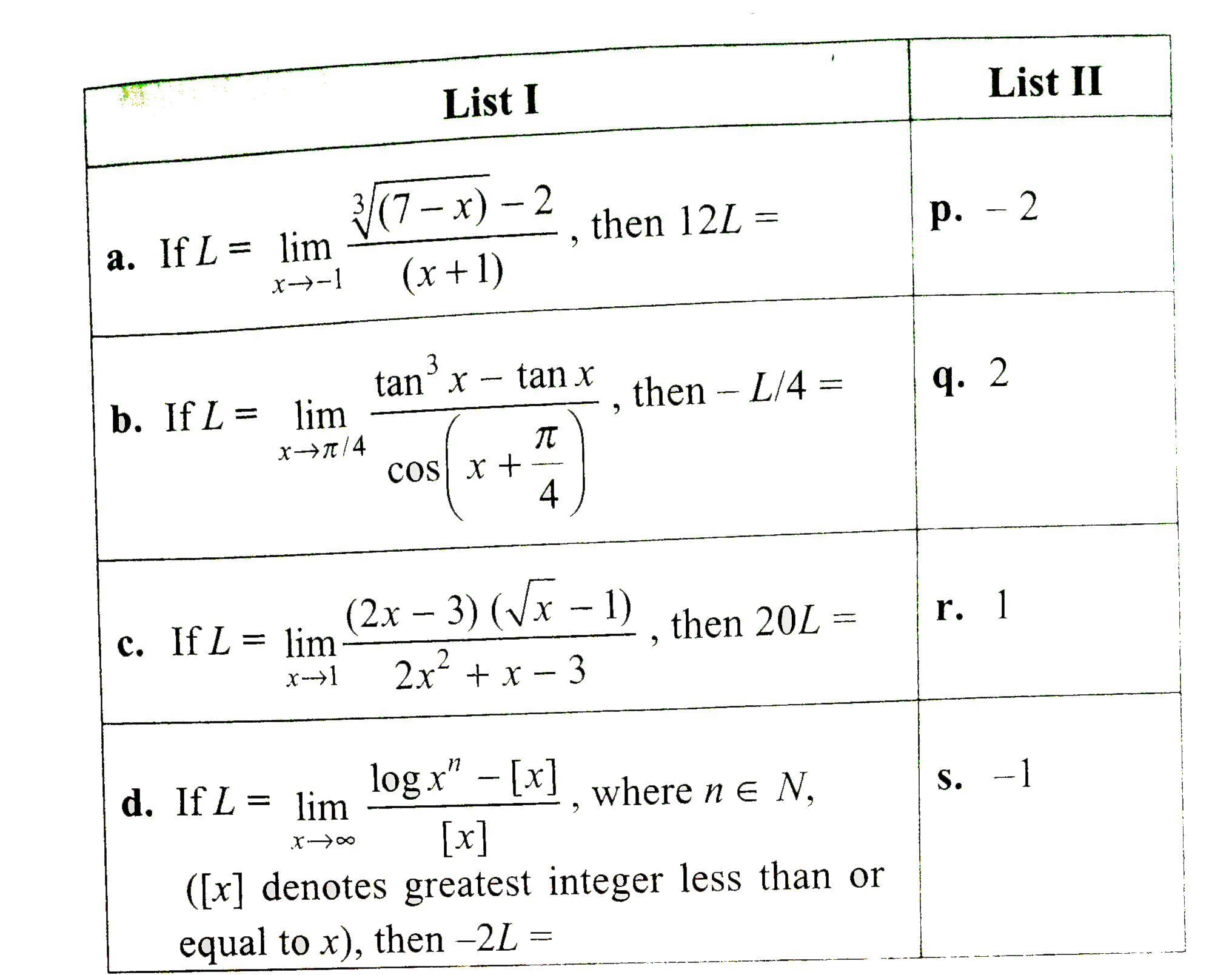Let a1>a2>a3...a>1 p1>p2>...pn>0 ; such that p1+p2+p3+pn=1 . Also F(x)=(p1ax1+p2ax2+...+pnanx)1x Then lim x→∞F(x) equalsSolution in Tamil
lna1
lnan
a1
an
The correct Answer is:D
Letlimx→∞F(x)=L
∴ lnL=limx→∞p1ax1lna1+p2ax2lna2+...+pnaxnlnanp1ax1+p2ax2+...+pnaxn
Dividing by (an)x and taking limx→∞(a1an)x,(a2an)x,etc. vanish.
Therefore,
lnL=pnlnanpn
or L=an
Topper's Solved these Questions
- BOOK - CENGAGECHAPTER - LIMITSEXERCISE - Exercise (Matrix)5videos
LIMITS
- BOOK - CENGAGECHAPTER - LIMITSEXERCISE - Exercise (Numerical)23videos
LIMITS
- BOOK - CENGAGECHAPTER - LIMITSEXERCISE - Exercise (Multiple)18videos
LIMITS
- BOOK - CENGAGECHAPTER - JEE 2019EXERCISE - Chapter 109videos
JEE 2019
- BOOK - CENGAGECHAPTER - LINEAR COMBINATION OF VECTORS, DEPENDENT AND INDEPENDENT VECTORSEXERCISE - DPP 1.210videos
LINEAR COMBINATION OF VECTORS, DEPENDENT AND INDEPENDENT VECTORS
Similar Questions
Match the following lists:
 00:59View Solution
00:59View SolutionThe reciprocal of the value of: (lim)n→∞(1−122)(1−132)(1−142)(1−1n2)is
04:26View SolutionLet f(x)={1+2xa,0≤x<1ax,1≤x<2.If(lim)x→1f(x)eξsts,thenais 1 (b) −1 (c) 2 (d) −2
01:14View SolutionIf y = y(x) is the solution of the differential equation, xdydx+2y=x2 satisfying y(1) = 1, then y(12) is equal to
View SolutionThe number of integral values of p for which (p+1)ˆi−3ˆj+pˆk,pˆi+(p+1)ˆj−3ˆk and −3ˆi+pˆj+(p+1)ˆk are linearly dependent vectors is q
View SolutionIf the lines p1x+q1y=1,p2x+q2y=1andp3x+q3y=1 be concurrent, show that the points (p1,q1),(p2,q2)and(p3,q3) are colliner.
02:08View SolutionConsider three planes P1:x−y+z=1,P2:x+y−z=−1,P3,x−3y+3z=2 Let L1,L2,L3 be the lines of intersection of the planes P2andP3andP−1,P1andP2, respectively.
03:43View SolutionIf P1,P2,P3,…..,Pn are co-primes then their LCM is……..
05:05View SolutionThe function f is defined by f(x)=13(x3+x2−11x−3) .
If p1,p2 and p3 are the zeros of f(x). Find the product p1p2p3 to the nearest integer.05:56View SolutionIf P1,P2,P3,………,Pn are n points on the line y = x all lying in the first quadrant, such that (OPn)=n(OPn−1) (O is origin ) , OP1= and Pn=(2520√2,2520√2), then n =
09:01View SolutionTwo numbers are respectively 20% and 50% more than a third number. The ratio of the two numbers is
02:11View SolutionLet f(x) = x log x +1 then the set {x : f(x)>0} is equal to
01:58View Solutionf(x)=e−1x,wherex>0, Let for each positive integer n,Pn be the polynomial such that dnf(x)dxn=Pn(1x)e−1x for all x>0. Show that Pn+1(x)=x2[Pn(x)−ddxPn(x)]
04:34View SolutionLet p1,p2,...,pnandx be distinct real number such that (n−1∑r=1p2r)x2+2(n−1∑r=1prpr+1)x+n∑r=2p2r≤0 then p1,p2,...,pn are in G.P. and when a21+a22+a23+...+a2n=0,a1=a2=a3=...=an=0 Statement 2 : If p2p1=p3p2=....=pnpn−1, then p1,p2,...,pn are in G.P.
04:08View SolutionTangent at a point P1 [other than (0,0)] on the curve y=x3 meets the curve again at P2. The tangent at P2 meets the curve at P3 & so on. Show that the abscissae of P1,P2,P3,.........Pn, form a GP. Also find the ratio area of A(P1P2P3.) area of Δ(P2P3P4)
09:26View SolutionIf X is a random variable whose possible values X1,X2,.....,Xn are occur with probabilities P1,P2,.....,Pn respectively, then E(X)=………….
09:23View Solution

